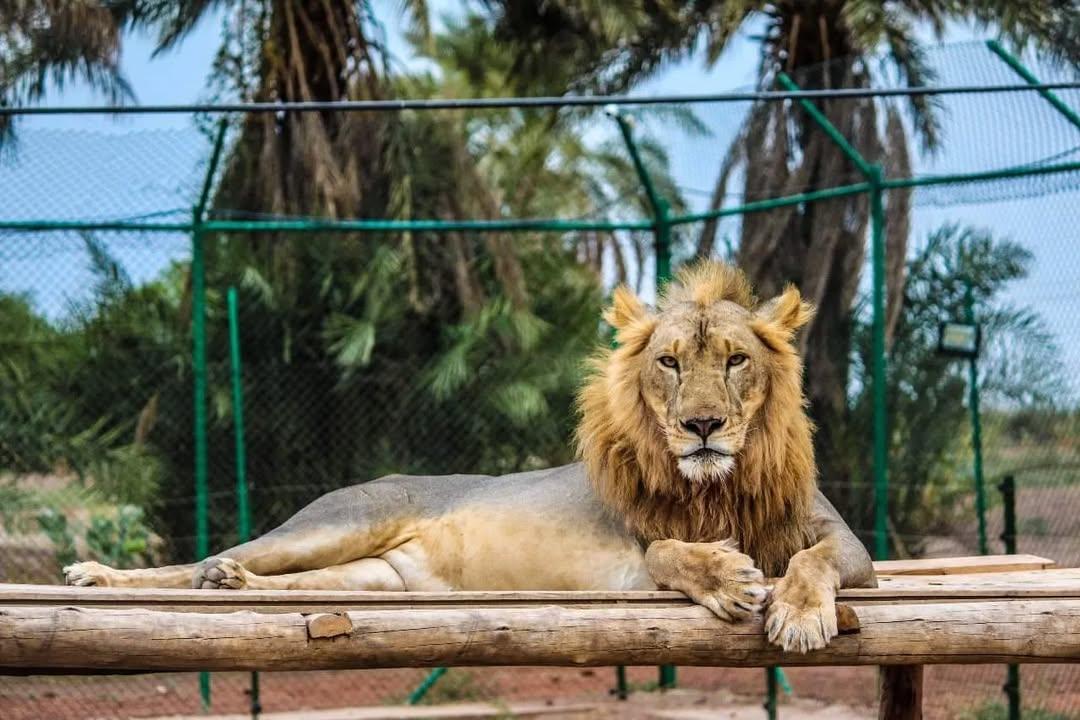
A Painful Journey Of Sudanese Wild Animal: From War To Peace
Portsudan-Sudanow
The little boy wondered in disappointment, "But where are the lions, Dad?"
The boy repeated the question again and again to his bewildered father, Othman,“But father where are the lions Dad” Othman did not answer. He could not answer and he could not himself speak. He was choked as well from the horror of what he saw. These animals in the cage could not be lions. A lion that he knew is the king of the jungle, a symbol of strength and courage. Othman Mohammed Salih was deeply saddened to see the lions in miserable state.
Othman and his son entered the zoo, their feet racing with joy to see the lions and the rest of the animals. As soon as they reached the lions' cages, what they saw shocked them. Inside the cage were three emaciated animals that did not resemble lions in anything. They were very weak, skinny and all but bones, as Othman described them.
There they were lying on the ground, their life and energy seeped out of bodies, unable to even stand on their feet let along roar. They looked they were about to perish.
They did not plan this visit. Their car broke down just a few meters away from the location, known as Al-Qurashi Park in downtown Khartoum. Othman had recently learned that the park had brought in a number of animals, including lions. He and his son were happy to be around and they thought it was a chance to enter the park and enjoy the company of the animals until the car has been fixed. When they reached the lions' cages, the tragedy struck them.
But despite his deep sadness at the animals' painful condition, he began to inspect the other cages, the hyenas and others, still unable to provide a satisfactory answer for his boy.
Here, his anger intensified at the mistreatment the animals were subjected to. He controlled himself and began to search for the man guarding the park, the zoologist, who explained that the lions were sick and were not fed properly because there was no budget to feed the animals in the park. On the spur of the moment Othman took a decision. He wanted to help out. He wanted to contribute in taking care of these poor animals. He spoke to the management and offered to help out. The people there were not, apparently, enthusiastic about that, but Othman had the experience and full knowledge in this field. Although he has been a software engineer, since he was young, but his love for animals and in raising and caring for animals was as old as he could not even remember. He grew up in an environment where everyone was interested in raising animals, starting from their large home (in Khartoum 2 district), which included in its backyard many types of birds, reptiles, turtles, dogs and cats, and ending with the farm that included cattle, deer and rabbits.
Their life was linked to those animals and how to take care of animals, sick and health. One of their most important duties as brothers and sisters within the family was to take care of those animals.
Then, in the weekend and on all holidays and vacations, they would visit the farm. Although there were workers who cared for the cattle and animals there, their role was not limited to inspecting production and take care of the animals' health, rather, they insisted on actively engaging in all farm work. Taking care of animal meant a lot to them. Their connection to their animals was strong, and this connection continued even when they traveled to Uganda as their father was relocated to that country within the international company shifts. But there in Uganda they found different animals, they acquired many of them, such as marine animals, colorful fish, reptiles, turtles: their hobby of taking care of animals continued.
Othman's family used to visit many African countries on vacation, and the basic program that everyone was waiting for and agreed upon was visiting the safari and reserves and watching lions, elephants, giraffes, and others.
Othman grew up and the same interest in animals grew inside him, and with the same passion, his eight-year-old son, who was with him on that visit, inherited that interest and attachment.
That visit was disastrous at first, but it turned into a blessing for those animals. When the officials showed their lack of enthusiasm vis-a-vis Othman's offer, he uploaded the video he filmed of those cages on social media, where he revealed the miserable condition of the animals inside them and what they suffered from: hunger, and disease and carelessness. That video received huge interests and reactions from officials in the country, especially in wildlife, and the concerned authorities and various media outlets, in addition to the great response he found from several external parties interested and organizations working in this field.
Othman was amazed by this great reaction and interest and began working with a group of young volunteers to rescue the animals. They were joined by a group of veterinarians who began treating them and tried to save them, but after two days one of the lions died. It was necessary to search for a party with more experience in wild animals. It was then that the Four Paws organization stepped in. It is an international organization known for working in many war and conflict zones such as Iraq, Palestine and Syria. They came to Sudan and began taking care of the animals. They held a number of training workshops to train the volunteers and provide them with sufficient expertise to handle animals in such a situation.
A parallel group of volunteers was also formed to back up the first group. Engineer Othman said that the volunteers, in cooperation with the competent authorities, made a significant effort to care for the animals since the beginning of its work in January 2020. The hurdles and challenges faced did not shy them away or weaken their resolve. The country was then undergoing difficult circumstances, especially the lockdown conditions during the Corona period. Rather, the group continued to provide its services of feeding, and cleaning. They could spot out clear improvement in the health of the animals, but there was a need to improve the situation, especially since the cages were not manufactured to the required specifications. The search was then turned for a place or large piece of land more suitable for the environment of wild animals.
Engineer Othman said that the process required resources and that they collected donations through the volunteer groups, but that was not enough to purchase the intended land, so he resorted to his uncles who welcomed the project and gave him an area of thirty acres of their farms (Muhammad Othman Saleh family) in the Baqir area, indicating that they began work on establishing the reserve by young volunteers, starting with excavation, construction, preparing the land, and then making the suitable cage for each group of animals, as this work consumed a whole year of relentless efforts.
According to Engineer Othman, the new phase of the project has brought about a major change as the animals were transferred from a small park in downtown Khartoum to a reserve in a vast area and a place similar to their natural habitats. This achievement was an incentive for Othman and his group of volunteers to complete the project, which is to establish a national reserve built around the core of the Al-Qurashi Park animals that were transferred to the reserve.
“We started by bringing in wild animals and birds scattered in public parks in other cities, in addition to animals owned by citizens.” He explained.
He pointed out that there were auctions to sell them,“but we in the reserve were keen to obtain and buy them instead of smuggling or exporting them, such as the lions that we obtained from the auction of Kuku area Park in Khartoum north. We also transferred lions, hyenas, birds and monkeys from the international park in central Khartoum to the reserve, in addition to the animals that we transferred from Port Sudan Park, in addition to the lions, hyenas, wild cats, turtles, different types of birds and snakes that citizens used to entertain at their homes. The reserve has become a national destination for tourism with its diverse animals, as it includes thirty-three different types of animals, including a large number of birds of different types and reptiles such as snakes, crocodiles and carnivores such as lions, hyenas and different types of wild cats in addition to turtles and three types of monkeys and more than ten types of birds in addition to deer and ostriches. Various parties began visiting the reserve, such as schools and universities, by organizing recreational trips for students, in addition to visits by families during the holidays. Then, the matter developed into private visits by ambassadors accredited to the country, especially from European countries such as Britain and Holland, whose ambassadors frequently visited the reserve, and Italy and others from America and African countries, especially the ambassador of Tanzania. Then, the reserve became a tourist destination for tourists through various tourism companies.”
He added that they received praise from many, especially tourists from France, Canada, and others, in addition to the visits made by famous artists and interested people. Days passed and the reserve flourished and became an important destination and facade that attracted tourism for three years until the war broke out in April 2023 and thus everything came to a halt.
Othman said that he did not leave Khartoum for a whole month after the outbreak of the war. He stayed to take care of the animals and he would move to them until the Rapid Support Forces took control of the Al-Baqir area where the farm is located. He said that the group continued for nine months, providing food for the animals in the reserve and providing salaries for the workers. He said that they continued to take care of them, indicating that it was one of the most difficult tasks, especially since the reserve contained twenty-five lions.
“We were afraid that they would escape or die, especially since the people of the Al-Baqir area did not leave the area.” Osman explained, adding that the situation had deteriorated a lot, so they started contacting the relevant international organizations and through the media, and the Four Paws organization responded and came to Port Sudan, and we started working on making the cages to transport them from the reserve. He said that the procedures and arrangements took a long time in light of the war conditions, as it was a great risk to bring in trucks and equipment for transporting them, such as cranes and others, with a group of foreigners from organizations and volunteers to the conflict zone through coordination with the army, security agencies, the Ministry of Interior, and Rapid Support Forces, indicating that the mission was completed successfully and all the animals were evacuated to Umm Baroun Park in Wad Madani, which was equipped to receive them, but the security situation did not stabilize and the Rapid Support Forces attacked Madani, so we were forced to transfer them to the Dinder Reserve, but they faced many problems, especially since the nature of the animals is different, as they were born in captivity and it is difficult for them to get used to the wild, so we were forced to transfer them to the Kassala City Park, then they were transferred to Sinkat City until they were transferred through the organizations and in coordination with wildlife, the Ministry of Interior, and relevant authorities to the Jordan Reserve, and another group to the South African Reserve. Osman told this magazine that there were twenty five lions at the beginning of the war. Two lions were taken from (Al-Qurashi Park) to the Jordan Reserve due to the deterioration of their health condition due to liver and kidney failure. Six of them died at the beginning of the war. Seventeen lions were rescued, fifteen of whom were deported outside the country, and along with five hyenas. As for the remaining gazelles and birds, the militia forces hunted many of them and the remaining number was transferred to Kassala. The foxes, monkeys and turtles were left in the reserve after they were released from the cages. Engineer Othman said that the militia destroyed the reserve and looted all the reserve's properties, including cars and others, but the same group is now ready to restore what was destroyed and return the reserve to its former glory and return the animals to it, especially since the agreement reached between the government and the relevant authorities and the organizations that rescued them is that the animals will return when peace is stored in the country.
++++++++++++++

Legal Disclaimer:
MENAFN provides the information “as is” without warranty of any kind. We do not accept any responsibility or liability for the accuracy, content, images, videos, licenses, completeness, legality, or reliability of the information contained in this article. If you have any complaints or copyright issues related to this article, kindly contact the provider above.






















Comments
No comment